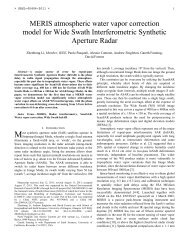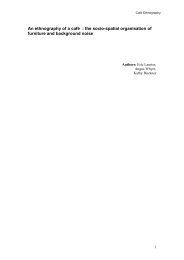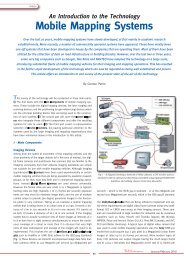Houdini and the wonder of
Houdini and the wonder of
Houdini and the wonder of
You also want an ePaper? Increase the reach of your titles
YUMPU automatically turns print PDFs into web optimized ePapers that Google loves.
start in <strong>the</strong> space after <strong>the</strong>y have witnessed what he is doing. There is no guarantee<br />
that <strong>the</strong> audience will realise <strong>the</strong>ir freedom having watched Blaine’s astounding show<br />
<strong>of</strong> human capability, it is something that he hopes for, as he hopes that <strong>the</strong>y will have<br />
a thought. Not about him. Not about taking up magic. Not ‘let’s explain magic’, not<br />
for his audience to walk away <strong>and</strong> reduce its amazingness to mere technologies <strong>and</strong> a<br />
deception for <strong>the</strong> purposes <strong>of</strong> enlisting <strong>the</strong>m into believing in <strong>the</strong> supernatural (always<br />
<strong>Houdini</strong>’s worry). While Blaine is willing to bring an audience to a state <strong>of</strong><br />
amazement through his spectacle, he is left with nothing to teach apart from how his<br />
magic is done, <strong>and</strong> that is not what he want to teach an audience, it is in what he<br />
would train only c<strong>and</strong>idate magicians.<br />
<strong>Houdini</strong> would arm himself to amaze even <strong>the</strong> ‘fault-finder’ in <strong>the</strong> audience (Phillips<br />
2001), <strong>the</strong> person who could say ‘oh it’s obvious how this trick is done.’ <strong>Houdini</strong> was<br />
seeking to show even <strong>the</strong> most sceptical person in <strong>the</strong> room <strong>wonder</strong>. He wanted to<br />
convert sceptics, <strong>the</strong>y were <strong>the</strong> acid test. And yet he wished still for <strong>the</strong>m to exercise<br />
<strong>the</strong>ir critical faculties <strong>and</strong> hence his huge disappointment when his friend Conan<br />
Doyle was ‘bewitched’ by <strong>the</strong> methods <strong>of</strong> Spiritualists (Phillips 2001). The surprise<br />
surely is not in Doyle’s <strong>wonder</strong> over magic but in his failure to grasp its technical<br />
details; since he is <strong>the</strong> creator <strong>of</strong> <strong>the</strong> detail-obsessed, uber-observer, Sherlock Holmes.<br />
Ethnomethodology is misunderstood, even by some <strong>of</strong> its practitioners, as only being<br />
about <strong>the</strong> details, mechanics, <strong>the</strong> devices <strong>and</strong> technologies whereby, say, ‘doing being<br />
ordinary’ is accomplished. This however is only half <strong>the</strong> story, just as for a magician<br />
recognition <strong>of</strong> <strong>the</strong> techniques is only half <strong>of</strong> doing magic, <strong>the</strong> constituent parts without<br />
<strong>the</strong> whole.<br />
It is ethnomethodological about EM studies that <strong>the</strong>y show for ordinary<br />
society’s substantive events, in material contents, just <strong>and</strong> only in any actual<br />
case, that <strong>and</strong> just how vulgarly competent members concert <strong>the</strong>ir activities to<br />
produce <strong>and</strong> show, exhibit <strong>and</strong> make observably <strong>the</strong> case*, demonstrate, <strong>and</strong> so<br />
on, coherence cogency, analysis, detail, structure, consistency, order, meaning,<br />
mistakes, errors, coincidence, facticity, reason, methods – locally, reflexively,<br />
naturally accountable phenomena- <strong>and</strong> as <strong>of</strong> <strong>the</strong> haecceities <strong>of</strong> <strong>the</strong>ir ordinary<br />
lives toge<strong>the</strong>r.<br />
We learn from <strong>the</strong> corpus <strong>of</strong> EM studies that its radical studies have begun to<br />
reveal immortal ordinary society as a wondrous thing [my emphasis]. Its<br />
members, be <strong>the</strong>y “lay analysts” or pr<strong>of</strong>essionals in <strong>the</strong> worldwide social<br />
science movement, with straightforward normal thoughtfulness are able to read<br />
it out <strong>of</strong> relevance, eyeless in Gaza, p202 (Garfinkel <strong>and</strong> Wieder 1992)<br />
Garfinkel even as he pushes toward <strong>the</strong> myriad practices whereby phenomena are<br />
constituted wants us to waken to <strong>the</strong> <strong>wonder</strong> <strong>of</strong> each phenomenon, as Wittgenstein<br />
wishes us to do <strong>the</strong> same (Bearn 1997). There is an orderly world all around us, we<br />
make it happen <strong>and</strong> it is <strong>wonder</strong>ful that it happens. The difference in examining,<br />
describing <strong>and</strong> analysing <strong>the</strong> unspectacular is that ethnomethodology (at least in<br />
places) <strong>of</strong>fers back to us how anyone, every competent person makes <strong>the</strong> sense <strong>of</strong> this<br />
situation, showing members to be like <strong>Houdini</strong>s in that <strong>the</strong>y have tricks to produce<br />
recognisable social objects. <strong>Houdini</strong>’s spectacle contains itself, we are not all about to<br />
become escape artists, <strong>the</strong>re should be only one amazing <strong>Houdini</strong>, one mysterious<br />
David Blaine! Always threatening to become hybridised out <strong>of</strong> existence with <strong>the</strong><br />
10
















